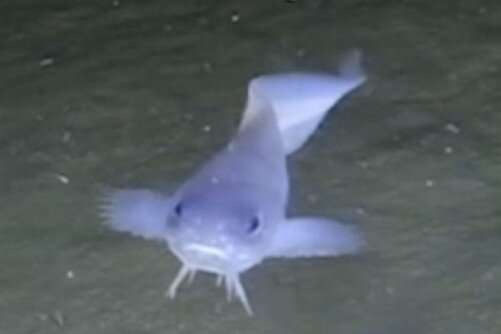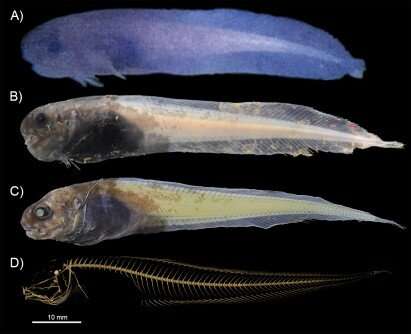
The Atacama Trench is a deep-water channel running along the Pacific coast of Chile and Peru, South America. In 2018, an international team of scientists used free-falling "landers" to study the trench, gathering images and specimens of deep-sea creatures. The team discovered a new snailfish species unique to the Atacama Trench and to all other known fish species.
The small blue fish, named Paraliparis selti by the team—"selti" meaning "blue" in Kunza, the language of the indigenous peoples of the Atacama Desert—lives in the hadal zone, waters deeper than 6,000 meters, or about 20,000 feet.
The newly discovered species "doesn't look like other snailfishes from the hadal zone, these ultradeep regions of the oceans," says Thomas Linley, Ph.D., Head of Technology, Armatus Oceanic. "It has large eyes, a striking blue color, and resembles other species of snailfishes that you would find living in much shallower waters." The article describing the team's discovery was published with open access in Marine Biodiversity.
Roughly 15 known species of hadal snailfishes inhabit the deep-sea trenches, with more being found each year. Most trenches house one species of snailfish, but researchers have found up to three different species occupying some trenches. These snailfishes (Liparidae) seem particularly good at living deeper than other fish. "They are not at all what we expect from a deep-sea fish," says Linley. "I love to show people that the world's deepest fishes are actually pretty cute."
The team used character trait analysis, a 3D X-ray technique called microcomputed tomography (micro-CT), and genetic barcoding to show that their blue snailfish belongs to the genus Paraliparis. "Species in this genus are particularly abundant in the Southern Ocean of the Antarctic and have rarely been seen deeper than 2,000 meters.," says Johanna Weston, postdoctoral fellow at Woods Hole Oceanographic Institution. "We were excited to see this result—this is the first time this genus has been found living in the hadal zone."

The researchers say the new species may have evolved from the cold-adapted species of the Southern Ocean. "This little blue fish opens up new questions about the relationship between cold temperature and high-pressure adaptation and gives a new understanding of how and when life evolved into the deep," says Mackenzie Gerringer, assistant professor at the State University of New York at Geneseo. "It's a reminder of the unique diversity yet to be discovered thriving in the deepest parts of our oceans."
Provided by State University of New York at Geneseo
Citation: A small trench-dwelling fish makes a splash in deep-sea evolution (2022, October 12) retrieved 12 October 2022 from https://ift.tt/19pyY3Q
This document is subject to copyright. Apart from any fair dealing for the purpose of private study or research, no part may be reproduced without the written permission. The content is provided for information purposes only.
"fish" - Google News
October 13, 2022 at 03:54AM
https://ift.tt/19pyY3Q
A small trench-dwelling fish makes a splash in deep-sea evolution - Phys.org
"fish" - Google News
https://ift.tt/2oiD58y
https://ift.tt/mKdcPV9
Bagikan Berita Ini















0 Response to "A small trench-dwelling fish makes a splash in deep-sea evolution - Phys.org"
Post a Comment